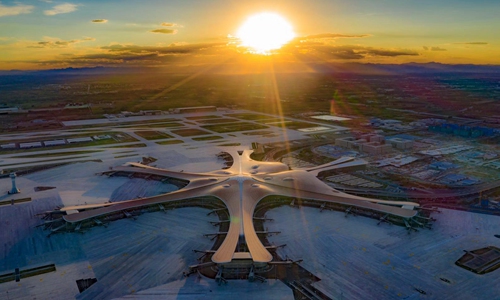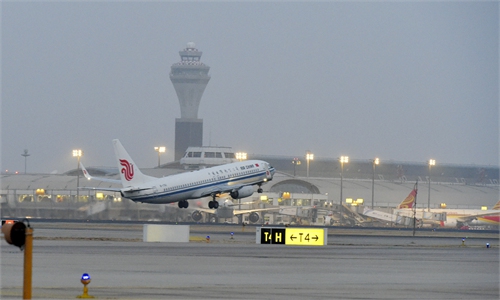
Aerial photo of the Phoenix-shaped terminal of Daxing Airport in southern Beijing. Photo: Courtesy of Tao Ran
As Beijing implements a stricter policy for inbound flights to the capital, market watchers are concerned that the move will further hurt the airline income amid challenging market conditions.
Beijing authorities said on Tuesday the city will cut inbound flights from provincial-level regions with either middle- or high-risk COVID-19 areas as part of its latest or strictest pandemic prevention measures ahead of the Beijing 2022 Winter Olympics.
Flights to Beijing from the capitals of provincial-level regions that have middle- or high-risk COVID-19 areas will be limited to one per day at less than 75 percent seating capacity, according to Ren Chaozhong, an official from the Civil Aviation Administration of China (CAAC).
Flights to Beijing from cities that are designated as middle- or high-risk areas will also be temporarily suspended, Ren added.
Official information showed that as of Wednesday, the provincial capital cities that including high-risk areas were Harbin in Northeast China's Heilongjiang Province, Shijiazhuang, North China's Hebei Province, Chengdu in Southwest China's Sichuan Province, Yinchuan, Northwest China's Ningxia Hui Autonomous Region, and Zhengzhou, Central China's Henan Province.
Prior to these new measures, many capital cities were still able to schedule high frequency flights to and from the capital.
Yicai.com reported that flight schedules will be arranged by regional administrations in determining which routes are kept in place.
Chengdu, which is already a medium-risk area, reduced the frequency of entry to Beijing as early as last week. Currently, daily flights from Chengdu to Beijing are being operated solely by Sichuan Airlines and Air China in rotation.
In addition to the reduction of flights, inspections for entry into Beijing will also be stricter. Ren said that the front-line inspection will be further strengthened.
According to the requirements issued by the CAAC, all airlines and airports shall strictly measure the temperature and check health codes. All passengers entering or returning to Beijing will be required to produce a negative nucleic acid test conducted within 48 hours before boarding.
Industry watchers said that the above-mentioned measures will drastically reduce the number of passengers entering Beijing, which will further cut domestic airlines' revenue forecasts.
Prior to the introduction of these new rules, the number of flights into and out of Beijing had already been scaled back.
Data from information provider VariFlight showed that, in the past seven days from November 10 to Tuesday, the daily average number of inbound and outbound flights at Beijing Capital International Airport was around 400 aircraft, with the average daily inbound and outbound flights at Beijing Daxing International Airport less than 300.
In October, the daily average number of inbound and outbound flights at the Capital Airport was nearly 800, with Daxing at 650. Starting from October 25, the two Beijing airports began to gradually reduce capacity.
Global Times

